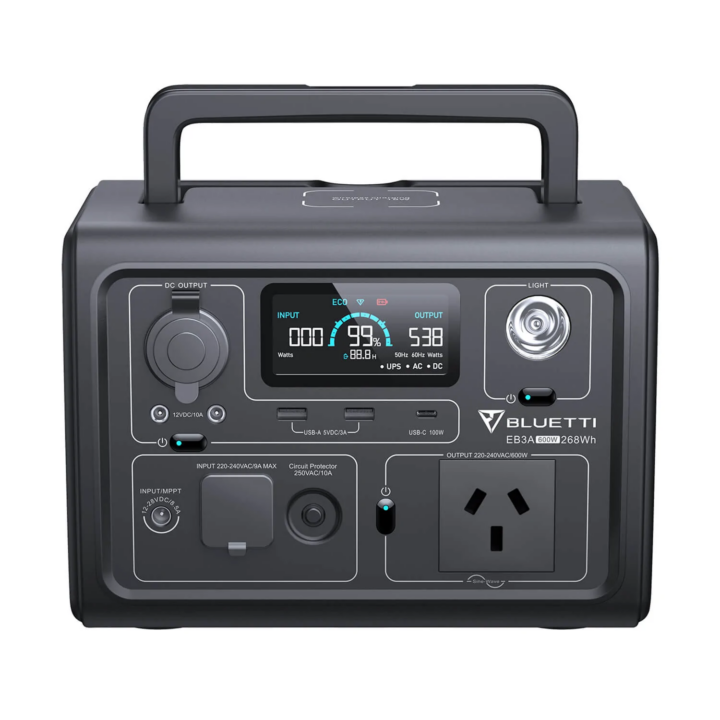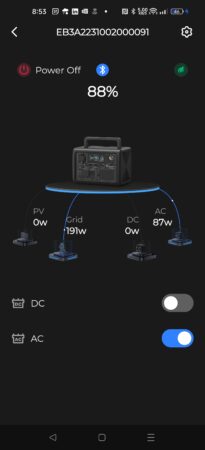Growing up in the seventies in Sydney, it was common to have blackouts. As adults, we took our kids camping only to have a flat car battery in the morning as they had used the car as their private cinema the night before. A portable power station like the Bluetti EB3A could spell the end of such dilemmas.
Whether you need a small backup power generator for important home devices or need an electricity source while travelling, this power solution could be what you’re looking for.
Bluetti EB3A Portable Power Station
| Australian Website | Bluetti |
| Manual or Support pages: | User guide, video |
| Price | A$599 (discounted to $499 at the time of writing) |
| From | Bluetti |
| Warranty | 24 months |
| Country of Manufacture | China |
| About | For over 10 years, BLUETTI has committed to building the world’s best off-grid power stations for van life, camping, and home backup. |
What is a Portable Power Station?
A portable power station, sometimes called a solar generator, is a rechargeable battery pack with a DC and/or AC outlet. Ultimately, it lets you charge or power your electronic devices and appliances.

The theory behind portable power stations is that they’re an evolution of the old petrol generators, providing a cleaner and quieter alternative. Its purpose remains the same: having an electricity source in an emergency or when travelling. For example, if there’s a blackout, you can still power important devices like a CPAP machine or refrigerator.
One big benefit is portability, allowing you to take electricity to where it is needed. If you are a tradie who needs to power a 240-volt saw on a job site or recharge your batteries for your cordless drill, you are good to go. In a remote camping spot, you can run a 12-volt fridge, recharge your phone or drone, and perhaps power a TV.
Unlike some petrol generators, a portable power station produces a sine wave output, ensuring your electronic devices, such as computers, are kept safe and can be recharged from the sun.
Unpacking the Bluetti EB3A
The words power station immediately make you think big and heavy. However, the Bluetti EB3A weighs in at 4.6 kg and measures 255 x 180 x 183mm making it highly portable, especially with a fold-down carry handle.
The EB3A is the baby of Bluetti’s range of power stations which increase in size and weight based on their ability to store and power larger electric appliances. This unit has one 240-volt power point capable of supplying up to 600 watts with a pure sine wave. Look on the back of the electrical appliance you want to use to find a label quoting how many watts the machine needs.
A 12-volt 10-amp car outlet will allow portable fridges or camp lights to be run with DC power. Your mobile phone can be charged wirelessly via a 15-watt pad on the unit’s lid. Alternatively, other electronic devices can be charged via two USB-A standard sockets or a 100W USB-C power delivery socket suitable for powering modern laptops.
The Bluetti uses LiFePO4 (Lithium Iron Phosphate) batteries which are heavier proportionally than the battery in your smartphone but will last much longer and are safer. The 268 Watt-hour battery has a life span of more than 2,500 cycles to 80% of its original capacity. This means if you charged it from empty every day, it would last 7 years.
To illustrate how its capacity, a full battery can charge your smartphone around 25 times, a drone 4-5 times, and a laptop 3-4 times. Also, you could run a 20-watt fan for 11 hours, a CPAP machine for 9 hours and 5 watts of lighting for more than 30 hours.
Inside the box, you get a 240-volt cable and a solar panel cable for charging alongside the main unit. An optional 12-volt car charging cable is available for $20, which we would have liked to see included.
Features of the EB3A
One helpful feature is the ability to monitor the battery via the Bluetti smartphone app. Here, you can check on the EB3A using Bluetooth from within 10 metres. The app also lets you control the battery’s inbuilt light plus the AC or DC sockets, all from your sleeping bag.

From the App, you can also regulate charging modes between standard, turbo and quiet. Fast charging uses a fan, while quiet mode makes less noise but charges slower, not that the fan is particularly loud. Turbo mode charges even faster but will negatively affect the long-term battery life if used regularly. In turbo mode from flat, it only takes 40 minutes to reach 80% using mains power, while a full charge will take 80 minutes. From a 12-volt car charger, charging time is three hours and 45 minutes. Another charging option is solar power. Bluetti sells suitable panels to charge the EB3A in 2-3 hours from $399.
The Bluetti is versatile as we can use it during a blackout at home, take it camping, or charge cordless power tools on the job site. An extra handy feature is its status as an uninterruptable power supply (UPS). This means that if you plug in the EB3A to mains power, and then attach critical devices to the portable power station, they will continue operating uninterrupted should a blackout occur.
Using the Bluetti EB3A portable power station
Helpful information such as battery percentage, and input and output watts read clearly on the EB3A’s LCD display. It’s also nice to have a remaining time readout, estimating how long the battery will last based on what you have plugged in. When charging the unit, a corresponding readout tells you how long until it reaches capacity.

The official specification for the EB3A is it powers up to a 24-volt, 600W appliance. The specification also says it can surge to 1200 watts. Surge allows a motor to start as the act of the first turn requires a surge of extra power.
One specific trial I ran involved powering an 1800-watt hair dryer using the EB3A. This theoretically shouldn’t be possible based on the specifications I just cited, as the station’s safety mechanisms turn the unit off.
However, the powerlifting mode, accessible from the app, makes this possible. Before using this mode, there are two important factors to take into account. First, it will drain the battery quickly, and secondly, it achieves this by dropping the voltage meaning the hair dryer runs at half speed. High-wattage sensitive devices like gaming computers or washing machines should not be used in this mode.

I also tested my 12-volt 50-litre travel fridge in the back of my car. When travelling, I could connect the EB3A to the car’s 12-volt cigarette plug while keeping the fridge (40W) running. This allowed me to top up the battery during the day when driving and then run the fridge all night with the car ignition off. Most importantly, the milk in the fridge stayed cold.
The solar panels available from Bluetti are light, fold up and have a rear stand to maximise the panels’ angle with the sun to generate the most power. The supplied cable has industry-standard MC4 connectors allowing use with cheaper, heavier fixed solar panels. I unsuccessfully tested a house solar panel just outside the voltage range, meaning the spec of 12-28 volts / 8.5 amps must be adhered to.
GadgetGuy’s Take
The Bluetti EB3A is an ideal short-term power supply when on the go or a peace-of-mind device at home. From powering a portable 12-volt fridge to keeping your tablet or drone juiced up, it tackles the job capably. 240 volts is just the press of a button away, so you can even use low-wattage appliances like a blender to tame that smoothie addiction when camping.
At less than 5kg, the EB3A is easy to carry but comes at the expense of a small 268Wh battery. Ultimately, though, it’s an affordable and convenient portable power station fit for purpose.
The post Bluetti EB3A review: a capable portable power station appeared first on GadgetGuy.



0 (mga) komento:
Mag-post ng isang Komento